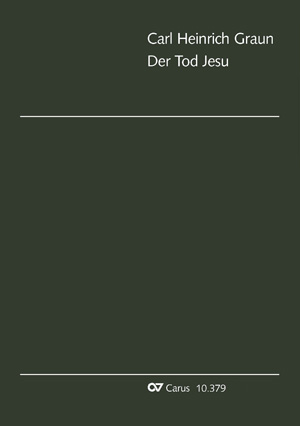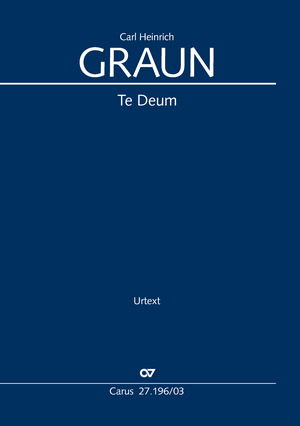
Der Tod Jesu
1755
-
Composer
Carl Heinrich Graun
| 1703-17591714 Besuch der Dresdner Kreuzkirche, 1724 Sänger in Braunschweig, später dort Vizekapellmeister, 1735 Vizekapellmeister am Hof in Berlin, seit der Thronbesteigung Friedrich des Großen 1740 schließlich dort Kapellmeister. Personal details
-
Editor
Herbert Lölkes
Reviews
Carl Heinrich Grauns: Der Tod Jesu
Carl Heinrich Grauns: Der Tod Jesu
Carl Heinrich Grauns „Der Tod Jesu”, 1754/55 entstanden, zählt zu den populärsten Passionsoratorien des 18. und 19. Jahrhunderts, wobei allein in Berlin bis 1884 das Werk über 70 Mal erklang. Ramlers Libretto, welches Graun (1703 od. 04 bis 1759), einer der bekanntesten deutschen Komponisten neben Johann Adolf Hasse und Georg Philipp Telemann, seinem Werk zugrunde legte, enthält, ähnlich einer Evangelienharmonie, Erzählelemente und Motive aus allen vier Evangelien. Gegliedert in 8 Rezitativen, 6 Arien und 5 Chören sind noch weitere 6 Choräle enthalten, deren Text teils von Ramler selbst, teils Berliner Gesangbüchern seiner Zeit entnommen wurden. Ein großes Werk, das einerseits zu Unrecht im Schatten der großen Passionen Bachs steht, das andererseits mit seinen groß angelegten Arien und Chören eine äußerst lohnende Aufgabe für Chor, Solisten und Orchester darstellt!
Walter Sengstschmid
Quelle: Singende Kirche 2/04
Der „Königlich Preußische Capellmeister” Carl Heinrich Graun zählte zu den bekanntesten deutschen Komponisten seiner Zeit, allerdings nicht hauptsächlich als Schöpfer dieser Passionsvertonung, sondern durch seine zahlreichen italienischen Operae seriae. Viel gerühmt wurde er besonders für seine kompositorische Darstellung rührender Gemütszustände, die als wunderbar ausdrucksvoll bezeichnet wurden. Stark von solchen - ganz der Epoche der Empfindsamkeit entsprechenden - Stimmungen geprägt ist auch sein 1754/55 entstandenes Oratorium Der Tod Jesu, ein Werk, das schon bei seinen Zeitgenossen großen Anklang fand und noch im 19. Jahrhundert auf Wunsch König Wilhelm I. regelmäßig von der Berliner Singakademie aufgeführt wurde.
So ist dieses knapp anderthalbstündige Oratorium ein Werk, das heute vermutlich nicht mehr der Idealvorstellung karfreitäglicher Kontemplation entspricht, das in seiner harmonischen Klarheit und seinem Melodienreichtum aber gerade auch die Laien im Publikum ansprechen dürfte und schon deshalb wieder häufiger aufgeführt werden sollte.
Die bei Carus erschienene Partitur nach dem Erstdruck von 1760 erfreut durch klares Druckbild und historische Treue. Die Schlüsselung wurde modernisiert. Ergänzungen sind als solche gekennzeichnet, der Generalbass ist nicht ausgesetzt, ein kritischer Bericht ist beigefügt. Bleibt zu hoffen, dass dieser neuen Partitur neue Aufführungen folgen werden!
Andrea Braun
Quelle: Das Orchester, 9/05, S.82
Frequent questions about this work
What is the situation with the source material for this work?
What are the key features of the Carus edition?
Which challenges face the performers?
What should be observed in the recitatives?
How should the chorales be performed?
What could be used to complement this work in a Passiontide concert?
 There are no questions and answers available so far or you were unable to find an answer to your specific question about this work? Then click here and send your specific questions to our Customer Services!
There are no questions and answers available so far or you were unable to find an answer to your specific question about this work? Then click here and send your specific questions to our Customer Services!






